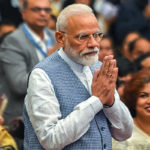Political scientist Christopher Clary discusses issues pertaining to strategic stability in South Asia.
By Ankit Panda April 23, 2019
Following a terror attack claimed by the Pakistan-based group Jaish-e-Mohammed in mid-February 2019, India and Pakistan were thrust into their most serious crisis since 2002. Since 2002 — and since the breakout of both countries as nuclear weapons possessors in 1998 — both India and Pakistan have calibrated their nuclear forces and strategies to meet the requirements of deterrence. Christopher Clary, an assistant professor of political science at the Rockefeller College of Public Affairs and Policy at the State University of New York’s University at Albany, and his co-author Vipin Narang, an associate professor of political science at the Massachusetts Institute of Technology, argued in a recent International Security article that India, in particular, has over the years developed a set of capabilities that suggest the temptation — if not a political decision — to move toward a nuclear strategy predicated on destroying Pakistan’s nuclear weapons. To discuss their article and other recent developments, including India’s test of an anti-satellite weapon, The Diplomat’s Senior Editor Ankit Panda spoke to Clary.
The Diplomat: From Pakistan’s perspective, which new Indian capabilities do you think might be viewed as the most destabilizing? Which capabilities has Pakistan started investing in as a result?
Christopher Clary: The argument that Vipin and I try to make in our piece is that it is important to assess these capability acquisitions collectively. India’s ability to destroy Pakistani nuclear weapons is useless if it does not have the ability to find those weapons in crisis and conflict. India’s ability to locate weapons is useless if it cannot hit them. India’s nascent ballistic missile defense capability seems innocent unless you combine it with growing Indian potential to destroy a sizable portion of Pakistan’s long-range nuclear systems, substantially easing the requirements for successful defense.
Now, Pakistani analysts and government officials have been complaining about Indian strategic developments for decades. Very few of these developments were deeply classified only to have been revealed recently. The issue is that outside analysts typically assumed that Indian efforts to develop precision-strike, nuclear-capable missile systems as well as ballistic missile defense technology were just DRDO [Editor’s note: India’s Defense Research and Development Organization, the primary government agency charged with the development of indigenous weapons systems] science projects. All these systems, all these tests, all these DRDO press releases were explained away as an amalgam of technological determinism, status-seeking, and inadequate political oversight of defense R&D. That argument, which was never very reassuring from a strategic stability perspective, now looks much weaker as these costly Indian investments continue. And influential Indian interlocutors, such as former Strategic Forces Commander Balraj Nagal, are now on the record explicitly rejecting such an interpretation.
Pakistan, which was worst-casing Indian developments the whole time, now looks less paranoid than it once did. All of its fissile material production capacity, which seemed excessive, makes more sense as an insurance policy. And its developments of short-range systems designed to avoid Indian missile defenses as well as MIRVs seeking to overwhelm defenses also make sense in this context. Now eventually Pakistan might wreck its economy and be unable to compete, but its current ability to keep up in any arms race lead Vipin and I to conclude that India’s pursuit of counterforce options is likely harmful to Indian interests, even as we are sympathetic to the strategic circumstances that motivated New Delhi to consider such options.
You and Vipin don’t conclude that India is likely to abandon its doctrinal posture of No First Use (with a carved out exception for biological and chemical weapons use against Indian forces). In the coming years, what indicators might we look for to predict that Indian doctrine itself might undergo review and change?
Well, if an Indian prime minister starts talking about how India isn’t keeping its nuclear weapons around merely for Diwali celebrations, then perhaps we can see glimpses that political leaders are concluding these weapons are more usable than previously believed. But more seriously: the signals India would send if it were to abandon no first use would be far stronger than it would send if it never had adopted NFU to begin with. And the thought experiment I would ask people to undertake is this: if India hadn’t announced NFU in 2003, do we think they would do so today if they were starting from scratch? I understand the incentives that led [former Indian National Security Advisor] Shivshankar Menon to conclude, and I’m paraphrasing, “You know what, if we need to pre-empt, the logic of the NFU commitment doesn’t preclude that. No need to change the doctrine. It’s sufficiently flexible to allow pre-emption if Pakistan is preparing to launch.” The evidence from other nuclear powers, especially the U.S. case, suggests there can be a profound disconnect between declaratory doctrine and targeting strategy, so I suspect India might avoid any public NFU reconsideration indefinitely.
India recently tested a modified Prithvi Defense Vehicle exoatmospheric kinetic interceptor against one of its own satellites, demonstrating for the first time a counterspace capability. How might the technologies demonstrated in that test influence Delhi’s strategy and options toward Pakistan?
As The Diplomat’s own reporting has emphasized, the test really had dual signals: about kinetic anti-satellite weapons as well as India’s increasingly capable ballistic missile defense capability. You can see that in DRDO’s own press release: they could have called the vehicle that smashed into their satellite any name they desired — Super Shakti Killer ASAT or what have you — but they opted to just refer to it as a “Ballistic Missile Defense Interceptor.” And it is perhaps equally significant that the so-called ASAT test demonstrated that India’s BMD could reach an altitude far higher than any previous BMD test and, in order to do so, could travel at a velocity considerably faster than any previous test. All of which would be useful to hit longer range Pakistani missiles.
The Indian Air Force struck Pakistani territory for the first time since the 1971 war at the end of February. Does that strike demonstrate that there may be more space for conventional brinksmanship and conflict under the nuclear threshold in South Asia? Will the Pakistani response deter India from future retaliation of this sort?
I also use the analogy of “space” to talk about India’s ability to engage in conventional attacks on Pakistan, but there is a flaw to the analogy, which is it makes it seem like all of a sudden there is a cliff or a wall. But that’s not how nuclear deterrence works. Instead, as India probes deeper into Pakistan, as it causes more pain and harm in its efforts to re-establish deterrence, it is dialing up the risk. If you pull the trigger in Russian roulette and no one dies, the correct lesson to learn is not that the game is totally safe! You can only infer that at least one of the barrels was empty. So I didn’t infer much from Balakot, to be honest.
I’ve been on the record since at least 2013 in saying that India would be strongly tempted to use standoff precision-strike capabilities in a future India-Pakistan crisis, that a more risk-acceptant Indian prime minister might do just that, that Pakistan would have some limited ability to use standoff capabilities in retaliating, and the principal reason not to engage in a standoff air strike is that it begins a tit-for-tat cycle that is difficult to escape. And I think that analysis holds up quite well. One surprise has been in India’s messaging after the strike, which seems to have assumed there was a 0 percent probability that the strike might not destroy the target. I don’t know whether any structure was destroyed by the strike, but I do think the confidence India has displayed in their capabilities — and my suspicion is that it is overconfidence — is exactly what I would expect for a country contemplating nuclear counterforce. Regarding future retaliation, I think we probably have to wait for the Indian election results to know whether a future Indian leader would look at what Modi did as a dangerous adventure or as a necessary (and popular) riposte.
How does the fact that India has to deal with a second nuclear-armed adversary — China — affect the development of its nuclear forces and conventional weapons? Is India’s deterrent against China credible today?
Personally, I think that the scenarios for India-China conflict are such that the requirements for nuclear deterrence are quite modest. The Himalayas make a great border and give India certain advantages that mitigate the overall military asymmetry with China. But many Indian elites — especially Indian military officers — disagree with me! They think India needs to do far more to deter China, including in the nuclear domain. The triangular competition considerably complicates arms race stability in southern Asia. Especially for movable or retargetable assets — think of aircraft, ships, missiles — India will always have to acquire sufficient numbers of these systems to hedge against the possibility of two-front wars and Pakistan will have to plan for the possibility that India will not have to fight a two-front war and can bring that extra military capability to the Indo-Pakistani fight. Given India’s size advantage — including economic — in the medium term there is no doubt that we will have to transition to an India-Pakistan competition where there is an undeniable conventional military imbalance. And it’s not at all clear to me that transition can occur without enormous danger.
This interview has been edited.


